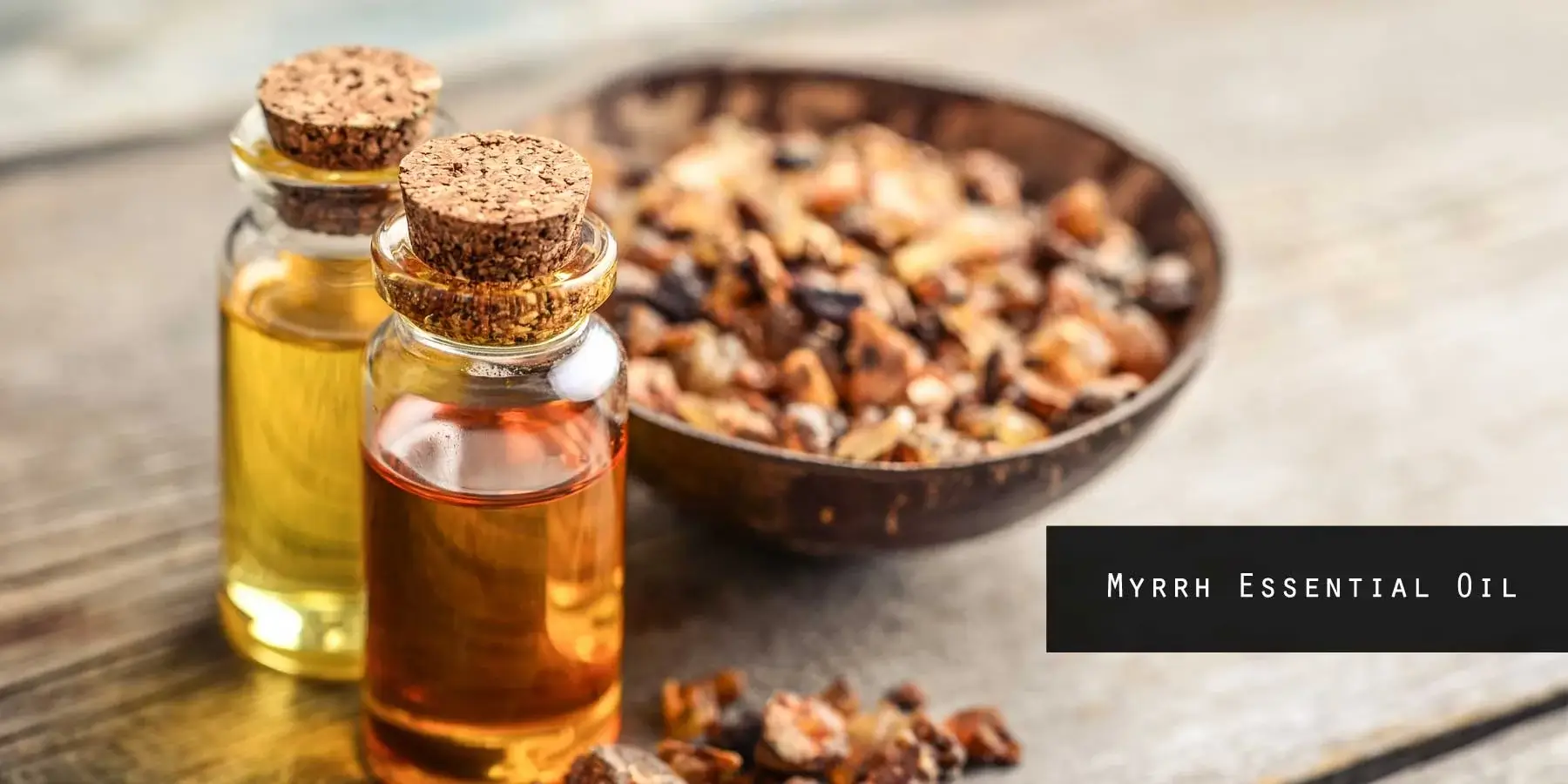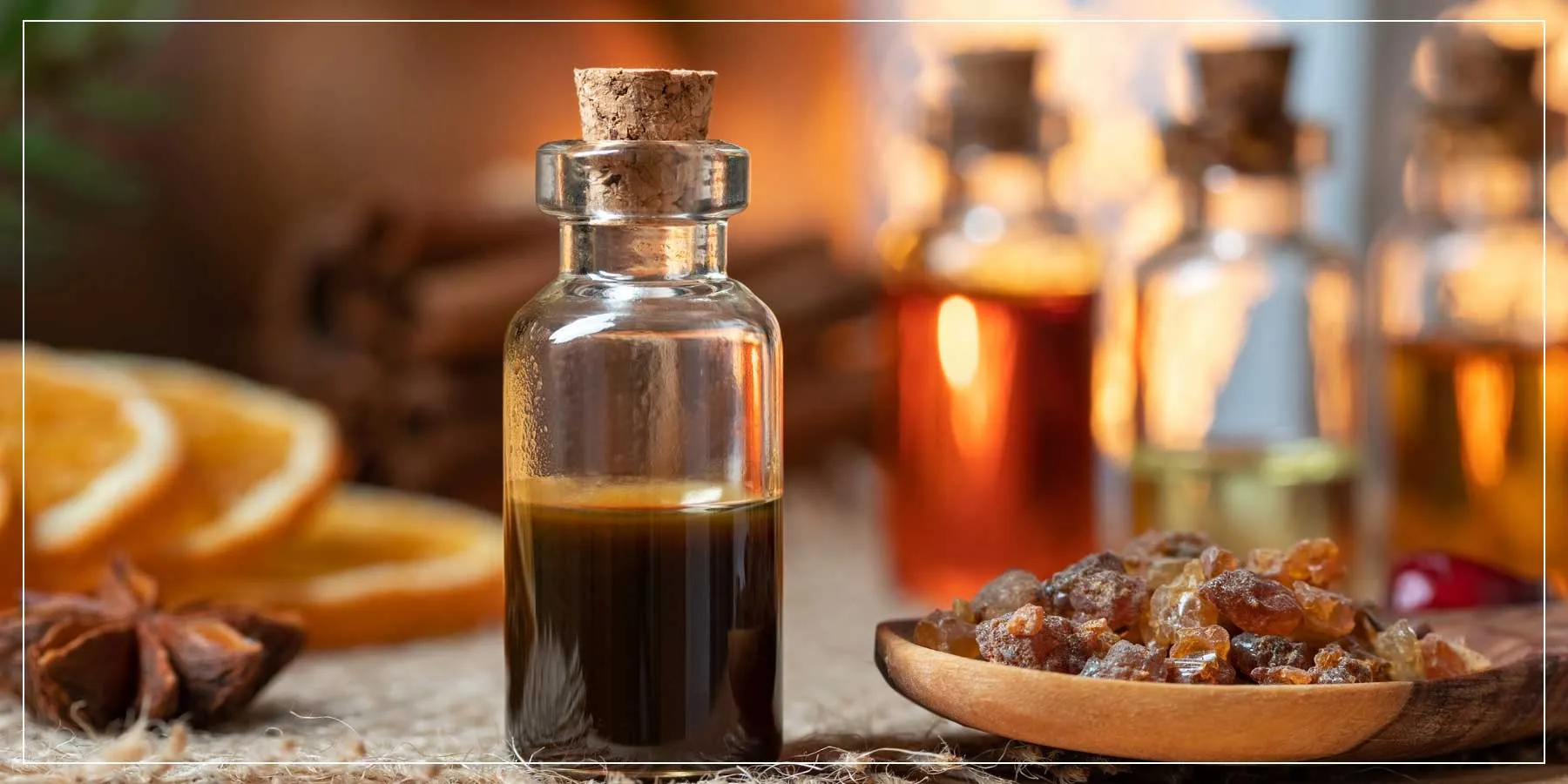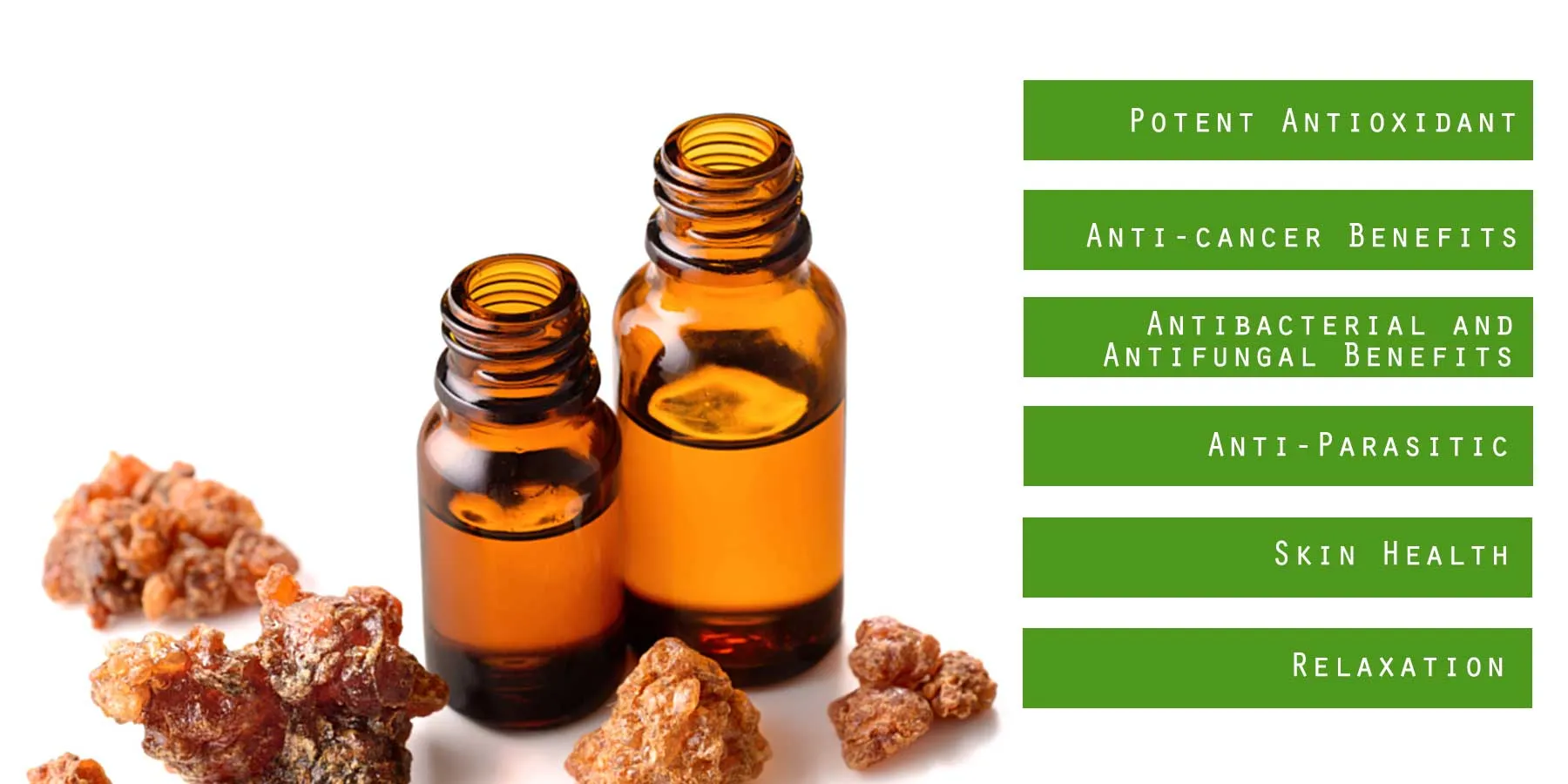Myrrh Essential Oil

While being famous for one of the gifts given to the baby Jesus in The Bible, Myrrh Oil is amazing in its own right.
What Is Myrrh?
Myrrh is a resin, or sap-like substance, that comes from a tree called Commiphora myrrha, common in Africa and the Middle East. Myrrh is botanically related to frankincense, and is one of the most widely used essential oils in the world.
The myrrh tree is distinctive due to its white flowers and knotted trunk. At times, the tree has very few leaves due to the dry desert conditions where it grows. It can sometimes take on an odd and twisted shape due to the harsh weather and wind.
In order to harvest myrrh, the tree trunks must be cut into to release the resin. The resin is allowed to dry and begins to look like tears all along the tree trunk. The resin is then collected and the essential oil is made from the sap via steam distillation.
Myrrh oil has a smoky, sweet or sometimes bitter smell. The word myrrh comes from the Arabic word “murr” meaning bitter. The oil is a yellowish, orange color with a viscous consistency. It is commonly used as a base for perfume and other fragrances.
Two primary active compounds are found in myrrh, called terpenoids and sesquiterpenes, both of which have anti-inflammatory and antioxidant effects. Sesquiterpenes specifically also have an effect on our emotional center in the hypothalamus, helping us remain calm and balanced. Both of these compounds are under investigation for their anticancer and antibacterial benefits, as well as other potential therapeutic uses.
Brief History of Myrrh Oil:

Myrrh essential oil has been used for thousands of years in traditional healing therapies and in religious ceremonies. Common myrrh oil uses historically, include:
- Fragrance
- Embalming
- Flavoring for food
- Treating hay fever
- As an antiseptic to clean and treat wounds
- As a paste to help stop bleeding
The Chinese frequently used myrrh as a medicine, and it remains a part of traditional Chinese medicine to this day. The main myrrh oil use by the Egyptians was for embalming and the Jews used it to make the holy anointing oil that was used in worship services.
Benefits of Myrrh Oil:

Myrrh oil has many potential benefits, although further research is needed to determine the exact mechanisms of how it works and dosages for therapeutic benefits. Here are some of the main benefits of myrrh oil use:
1. Potent Antioxidant
A 2010 animal-based study in the Journal of Food and Chemical Toxicology found that myrrh could protect against liver damage in rabbits due to its high antioxidant capacity. There may be some potential for uses in humans also.
2. Anti-cancer Benefits
A lab-based study found that myrrh also has potential anticancer benefits. The researchers found that myrrh was able to reduce the proliferation or replication of human cancer cells. They found that myrrh inhibited growth in eight different types of cancer cells, specifically gynecological cancers. Although further research is needed to determine exactly how to use myrrh for cancer treatment, this initial research is promising.
3. Antibacterial and Antifungal Benefits
Historically, myrrh was used to treat wounds and prevent infections. It can still be used in this manner on minor fungal irritations such as athlete’s foot, bad breath, ringworm (all of which can be caused by Candida), and acne.
Myrrh oil can help fight certain types of bacteria. For example, it seems in lab studies to be potent against S. aureus infections (staph). The antibacterial properties of myrrh oil seem to be amplified when it’s used along with frankincense oil, another popular biblical oil.
Apply a few drops to a clean towel first before applying it directly to the skin.
4. Anti-Parasitic
A medication has been developed using myrrh as a treatment for fascioliasis, a parasitic worm infection that has been infecting humans worldwide. Ingesting aquatic algae and other plants generally transmits this parasite. A medication made with myrrh was able to decrease symptoms of the infection, as well as a drop in parasite egg count found in the feces.
5. Skin Health
Myrrh can help maintain healthy skin by soothing chapped or cracked patches. It is commonly added to skin care products to help with moisturizing and also for fragrance. Ancient Egyptians used it to prevent aging and maintain healthy skin.
A research study in 2010 discovered that topical application of myrrh oil helped elevate white blood cells around skin wounds, leading to faster healing.
6. Relaxation
Myrrh is commonly used in aromatherapy for massages. It can also be added to a warm bath or applied directly to the skin.
How to Use Myrrh Oil:
Essential oil therapy has been used for thousands of years and is the practice of using oils for their health benefits. Each essential oil has its own unique benefit and can be incorporated as an alternative treatment to a variety of ailments.
Generally, oils are inhaled, sprayed in the air, massaged into the skin and at times taken by mouth. Fragrances are strongly connected to our emotions and memories, as our scent receptors are located next to the emotional centers in our brain, the amygdale and hippocampus.
1. Diffuse or Inhale It
You can purchase an essential oil distiller to use throughout the house when you are trying to achieve a certain mood. Or add a few drops to hot water and inhale the steam. Myrrh oil can also be inhaled when you are sick to help improve the symptoms of bronchitis, colds or coughs.
It can also be blended with other essential oils to create a new scent. It blends well with citrus oil, such as bergamot, grapefruit or lemon to help lighten up its fragrance.
2. Apply It Directly to the Skin
It is best to mix myrrh with one or more carrier oils, such as coconut, jojoba, almond or grape seed oil before applying it to the skin. It can also be mixed with an unscented lotion and used directly on the skin. Due to its antioxidant properties, it is great for anti-aging, skin rejuvenation and wound treatment.
You can also use myrrh to make various natural skin care products when it is blended with other ingredients. For example, consider making homemade Frankincense and Myrrh lotion to help treat and tone the skin.
3. Use as a Cold Compress
Myrrh oil has many therapeutic properties, therefore add a few drops to a cold compress and apply it directly to any infected or inflamed area for relief. It is antibacterial, antifungal and helps to reduce swelling and inflammation.
4. Relief for Upper Respiratory Problems
It may work as an expectorant to help relieve the symptoms of coughs and cold. Try this oil to relieve congestion and help reduce phlegm.
5. Decrease in Digestive Problems
Another popular myrrh oil use is to help relieve digestive problems such as stomach upset, diarrhea and indigestion.
6. Helps Prevent Gum Disease and Mouth Infections
Due to its anti-inflammatory and antibacterial properties, myrrh can help relieve inflammation of the mouth and gums caused by diseases such as gingivitis and mouth ulcers. It can also be used as mouth rinse to prevent gum disease. It can also freshen your breath and commonly used as an ingredient in mouthwash and toothpaste.
7. Helps Treat Hypothyroidism
Myrrh is a remedy for hypothyroidism, or a low functioning thyroid, in traditional Chinese medicine (TCM) and Ayurvedic medicine. Certain compounds in myrrh may be responsible for its thyroid-stimulating effects. Put 2–3 drops directly onto the thyroid area daily to help decrease symptoms.
8. May Help Treat Skin Cancer
As discussed above, myrrh is being studied for its potential anticancer benefits. It has been shown to be beneficial against skin cancer cells in laboratory studies. Consider using it in addition to other traditional treatments, if you have been diagnosed with skin cancer. Apply a few drops per day directly onto the cancer site, always testing a small area first.
9. Treatment for Ulcers and Wounds
Myrrh has the power to increase the function of white blood cells, critical for wound healing. It was found to decrease the incidence of ulcers and improve their healing time, in one study published in the Journal of Immunotoxicology.
A primary myrrh oil use is as a fungicide or antiseptic. It can help reduce fungal infections such as athlete’s foot or ringworm, when applied directly to the affected area. It can also be used on small scrapes and wounds to prevent infection.
Myrrh can help strengthen the body’s cells by acting as an astringent. It was used traditionally to help stop bleeding. Due to its astringent effects, it may also help prevent hair loss by strengthening the roots in the scalp.
Before Use:
Myrrh does have some side effects that need to be considered before using it therapeutically. As always, it is best to speak to your doctor or trusted health care provider first.
Since one of the most common myrrh oil uses is topical, people with sensitive skin should be cautious. Myrrh has been found to cause inflammation of the skin, in some people. Always test it first in a small area before applying it all over the skin to make sure you don’t have any allergic reaction.
- If taken internally, myrrh may cause stomach upset and diarrhea.
- Pregnant women should avoid taking myrrh because it may enhance uterine contractions.
- Another potential side effect of myrrh is heart irregularities and lowered blood pressure, although this is mostly seen at high doses of more than 2-4 grams per day. Anyone with a medical condition related to the heart should ask a doctor before using myrrh oil.
- Myrrh may lower blood sugar, therefore it is not recommended for people with diabetes or other blood sugar conditions. Since it interacts with blood glucose it is also not recommended for people undergoing surgery and it is best to stop its use at least two weeks before surgery.
- Myrrh oil is not recommended for people using anticoagulants such as warfarin (common brand names Coumadin and Jantoven) as it may have potential interactions with this medication. It is also not recommended for people on diabetes medication, as there is a potential for a drug interaction.
References:
RELATED POSTS